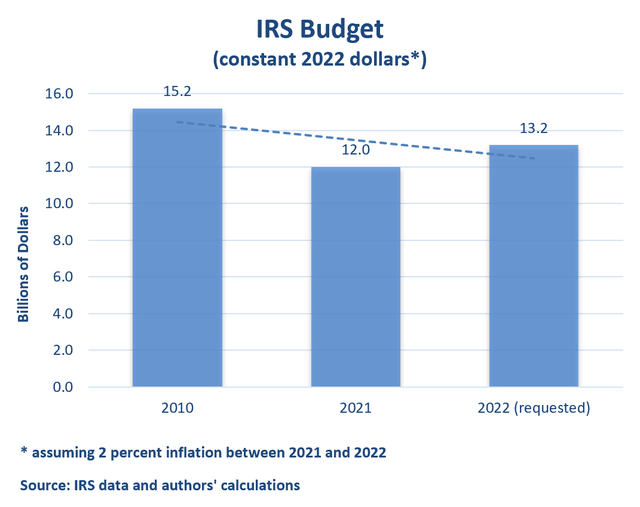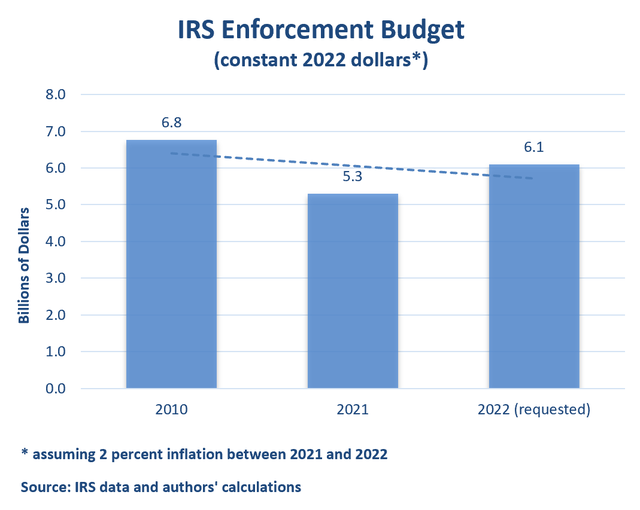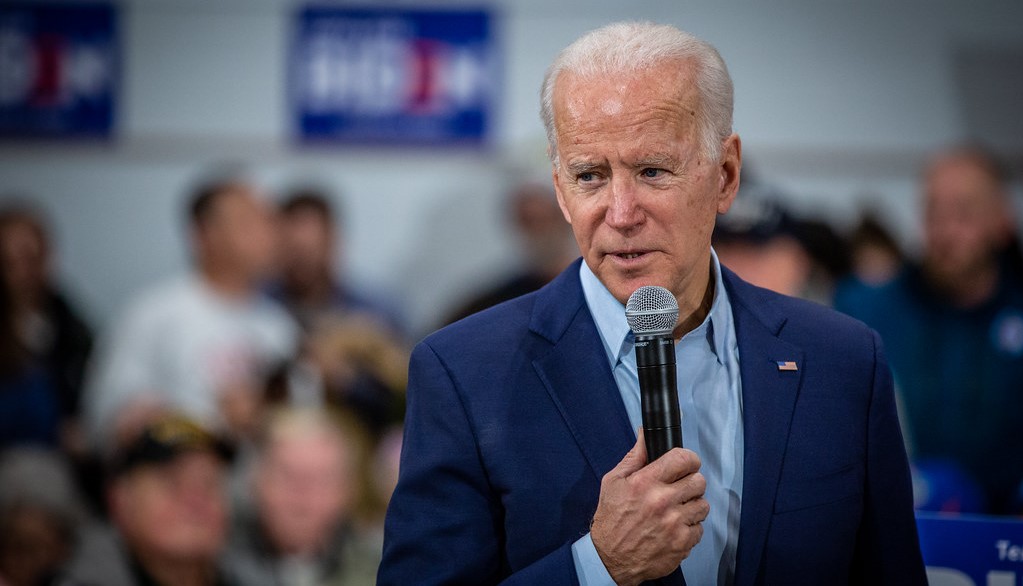Read this article on the original site.
President Biden’s inaugural annual budget request, which encompasses only discretionary spending (about a third of the federal budget), is a $1.52 trillion proposed investment in the federal government. The rest of the request, to be released later this spring, will include tax reforms and mandatory spending (which includes programs like Social Security, Medicare, and Medicaid) and provide a fuller picture of the administration’s priorities.
What we have now reflects a necessary step toward rebuilding government capacity and the civil service. Biden’s budget restores non-defense discretionary funding to 3.3 percent of GDP, close to the average over the last 30 years. But after decades of chronic underinvestment, Biden’s budget request is insufficient to undo all of that damage. For someone aspiring to an FDR-sized presidency, Biden—and Congress—must go much bigger to meet the needs of the American people.
How the Budget Process Works
The president’s budget request is a nonbinding outline of the president’s spending priorities for the upcoming fiscal year. While Congress may completely disregard the president’s budget, the Democratic-controlled House and Senate are likely to take their party leader’s budget as at least a starting point for their budget negotiations.
With the expiration of the Budget Control Act, an Obama-era austerity compromise with then–House Speaker John Boehner, at the end of this fiscal year in September, Biden’s budget request is not bound by any congressionally mandated spending caps. Congress will need to pass a new budget resolution for Fiscal Year 2022 before beginning work on the appropriations bills. Budget resolutions are filibuster-proof, and Congress will likely pass it on a party-line vote, should Democrats create sufficiently high budget caps. The budget bill itself requires the approval of at least ten Senate Republicans to avoid the filibuster.
Major Steps Forward
Biden’s budget represents one of the first big opportunities to restore the government, and many agencies would get huge boosts to their budgets at his requested levels of funding.
The budget would increase Department of Housing and Urban Development (HUD) funding by 15 percent compared to FY 2021, devoting a majority of the funds to programs designed to increase affordable housing and combat homelessness. Likewise, the Department of Health and Human Services (HHS) would receive a 23.5 percent increase, with much of the funding aimed toward combating public-health crises, including $10.7 billion to address the ongoing opioid epidemic and another $2.1 billion in spending across multiple agencies to combat gun violence.
Biden’s request for the U.S. Department of Education (ED) is the largest bump in funding, providing a 41 percent increase compared to FY 2021. This massive increase would go toward low-income schools to address disproportionate educational outcomes and to hiring school nurses and mental-health professionals at K-12 schools. For post-secondary education, the budget not only increases Pell grant benefit amounts by $400 but also opens the grants to DACA recipients who meet income requirements.
Further, the Department of Transportation budget would go up 14 percent, with a 35 percent budget increase for Amtrak, $625 million in grants to develop greater passenger rail systems, and a 23 percent increase to the Capital Investment Grants program, which supports public-transit systems. Other green-transportation spending includes $600 million for federal agencies to purchase electric vehicles and charging stations.
Among the most important line items attempt to rebuild staffing levels and capacity at federal agencies. Reeling from over 1,000 lost jobs in the past four years, Biden’s budget outlines a $110 million program to restore the Environmental Protection Agency (EPA) workforce. Similarly, he earmarks a 17 percent increase in funding for the Department of Labor (DOL) workplace safety agencies to rebuild investigation capacity and requests a similar program for the U.S. Geological Survey in the Department of the Interior. These programs will be crucial for restoring these agencies’ effectiveness after years of hiring freezes, politicization, and denigration of the civil service.
Not Enough
The budget request is a significant improvement on the past four years of Trumpian disaster. But the proper point of comparison for Biden is not Trump, a corrupt, anti-government belligerent who set the lowest of low bars. Instead, Biden must at least exceed the levels of government funding prior to the 2011 Budget Control Act, or, preferably, before Reagan-era budget cuts. Biden’s budget request may raise non-defense discretionary (NDD) spending to 3.3 percent of GDP, but such spending hovered around 5 percent in 1980, which would equal about $1.1 trillion today, compared to Biden’s $769 billion NDD figure.
For instance, though the 14 percent increase in funding for the DOL and 21 percent increase to the EPA do represent significant boosts relative to the Trump administration, neither of them would completely restore the funding these agencies were receiving during the Obama administration in FY 2010. Insufficient funding and budget cuts have also devastated the Internal Revenue Service since 2010, and while Biden’s budget does request significant increases to the IRS budget, it does not go far enough.
Biden’s budget requests $13.2 billion for the IRS, a 10.4 percent increase since 2021. The increased budget makes up approximately one-third of the loss in funding since 2010. The request also provides an additional $0.9 billion for enforcement, raising the enforcement budget to about $6.1 billion. Had the enforcement budget held steady since 2010, the FY 2022 enforcement budget would be $6.77 billion. Biden’s budget request makes up two-thirds of the budget shortfall since 2010.


The IRS is a crucial government agency; as one of the only ones that collects revenue, IRS funding has an average return on investment of 600 percent. And its responsibilities have ballooned in recent years. Between 2010 and 2020, the number of tax returns filed increased by 17 percent. During the same period, inequality rose, making audits on the wealthy even more complicated, as the IRS needed to parse new complex tax evasion schemes—something it was already struggling with. With increased returns, potential new tax reforms under President Biden’s jobs plan, and the American Rescue Plan’s new advanced, monthly Child Tax Credit payment, the IRS needs a significant funding infusion to hire and train the staff necessary to carry out its responsibilities. The IRS almost certainly needs a budget baseline far greater than the one it had in 2010, exceeding at least $18 billion.
Defense and Immigration Spending Continues to Fund Wasteful and Inhumane Programs
In an incredibly disappointing move, the Biden budget request holds the Pentagon budget steady relative to inflation with a nominal $12.3 billion increase. Progressives were pushing Biden to cut the inflated defense budget by 10 percent, a reasonable proposal which would have kept it higher in real terms in 2022 than it was in 2017. Keeping the budget flat is an explicit acceptance of Trump’s wasteful budget priorities for an agency that regularly fails audit.
Similarly, the budget request, while providing necessary increases in funding for processing naturalization and asylum cases, also increases the border security budget by $1.2 billion. The funding will purportedly go toward increasing the number of sensors to detect undocumented border crossers and strengthening ports of entry. This follows previous reporting on Biden successfully pressuring Mexico to ramp up its own anti-immigration measures.
Past presidents have tried similar policies, and the result has inevitably been humanitarian disaster. Making it more difficult to cross the U.S.-Mexico border has resulted in the deaths of thousands of migrants who, in order to avoid areas along the border with increased security, traverse more perilous portions of the border, such as the Sonoran Desert or the Rio Grande.
Building Back the Budget
There’s much to celebrate in the first half of the Biden budget. Education, housing, and public health all get desperately needed boosts, and the request has several provisions specifically for rehiring laid-off government workers and filling staffing shortages. But we can and should demand more and better. Trump cannot set the standards for the Biden presidency, and “sufficient” is not equivalent to “enough” when it comes to restoring a functioning federal government. Congress must take the Biden budget request for what it is—a nonbinding request—and go bigger in funding administrative capacity and rebuilding the government for the benefit of all.
Header image: “Joe Biden at McKinley Elementary School” by Phil Roeder is licensed under CC BY 2.0

